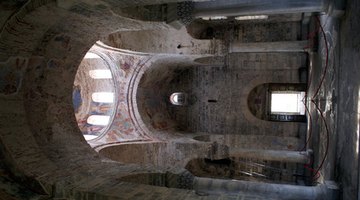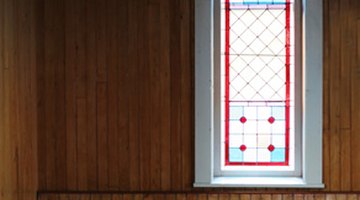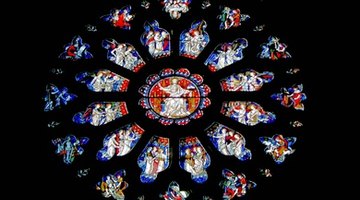The great churches and cathedrals of Europe have left a vast body of architectural elements that are used to this day. Although the interiors of modern churches have changed with improved building techniques, architects continue to draw inspiration from the great churches of the past, particularly when it comes to windows. Perhaps the most significant of architectural features in classic churches, windows were of deep symbolic interest, as well as being functional and beautiful.
Clerestory Windows

Clerestory (pronounced "clear-story") windows are a type of window popularised in churches and cathedral during the Romanesque period. They generally run along the top of the nave, or central approach to the altar, and provide abundant interior light in areas that would otherwise be very dim. Their sole function is to provide light, specifically ambient overhead light, and not to provide a view that might be distracting in a religious environment. Clerestory windows fell out of popularity in the early 20th century but were later revived through the works of Frank Lloyd Wright and are now commonly seen in church architecture, as well as secular buildings.
- Clerestory (pronounced "clear-story") windows are a type of window popularised in churches and cathedral during the Romanesque period.
- They generally run along the top of the nave, or central approach to the altar, and provide abundant interior light in areas that would otherwise be very dim.
Lancet Windows

Lancet windows are tall, narrow windows capped by a sharply pointed arch. They are named for their spearhead-like shape. Variations exist in the width of this type of window, but the overall shape is consistent. Common in Gothic architecture, lancet windows were sometimes made with stained glass, although given the austerity of the period they were generally free from ornamentation. They were typically built in pairs or even-numbered rows. Today, lancet windows are sometimes employed in church architecture because of their historic and religious significance.
- Lancet windows are tall, narrow windows capped by a sharply pointed arch.
- Common in Gothic architecture, lancet windows were sometimes made with stained glass, although given the austerity of the period they were generally free from ornamentation.
Rose Windows

Rose windows are among the most recognisable church windows. Originating from Roman sacred architecture, rose windows reinterpret the "oculus," or small, round pane-less window used in ancient temples such as the Pantheon. They are often highly decorative with ornate stained glass work and elaborate tracery. Rose windows are often the centrepiece of a church, located above or facing the altar. They reached their height during the Gothic period, when cathedrals throughout Europe began featuring them. Today, rose windows are beginning to appear again in church architecture, albeit in a more understated and less elaborate fashion.
- Rose windows are among the most recognisable church windows.
- Rose windows are often the centrepiece of a church, located above or facing the altar.
Cinquefoil Windows
Cinquefoil windows are ornamental structures consisting of five arches arranged in a circular pattern to resemble stylised five-petaled flowers. They are typically made with clear glass, although sometimes plain coloured glass is used. Historically, they appear in Catholic and Protestant churches equally, although in modern church architecture they are generally restricted to Catholic structures. Their purpose is to provide light to the aisles, which are out of the range of clerestory window light. Rarely, cinquefoil shapes are incorporated into rose window design, generally with highly ornamental tracery.
- Cinquefoil windows are ornamental structures consisting of five arches arranged in a circular pattern to resemble stylised five-petaled flowers.
- Their purpose is to provide light to the aisles, which are out of the range of clerestory window light.
